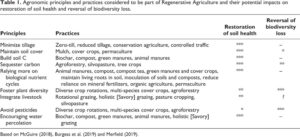Climate change is a serious issue in our world today. Agriculture, soil health, and biodiversity are all in trouble. Regenerative agriculture is part of the solution. An article from the Sage Journals addresses this issue from an agronomic perspective as well as which problems regenerative agriculture actually solves.
This paper specifically focuses on two questions:
(1) What is the agronomic problem analysis that motivates the Regenerative Agriculture movement and what is the evidence base for this analysis?
The two challenges that are most often linked to Regenerative Agriculture are the reversal of biodiversity and the restoration of soil health. These two issues are key factors that motivate farmers in the Regenerative Agriculture movement.
(2) What agronomic solutions are proposed, and how well are these supported by evidence?
Some of the agronomic solutions proposed in this article are to minimize tillage, maintain soil cover (for example: utilize cover crops), sequester carbon, rely on more biological nutrient cycles (examples: animal manure or composting), avoid pesticides, integrate livestock, and foster plant diversity. These practices are supported by a lot of evidence and various studies such as one in China that investigated potential soil C sequestration across a range of different cropping systems. The results showed that for a wide range of management practices and crop rotations, soil C sequestration compensated on average for 10% of the total GHG emissions, with a maximum of 30%.

The terms Regenerative Agriculture and Regenerative Farming have been in use since the early 1980s, however, they have not been as widely used as other related terms such as sustainable agriculture or organic agriculture until 2016. Since then their occurrence in news stories, books, and on the internet has increased dramatically. They have also been adopted by a wide range of multinational companies, NGOs, and charitable foundations. There is a danger of getting “greenwashed” with everyone increasing their use of this new buzzword. Greenwashing is when an organization or company focuses more time and money on marketing themselves as environmentally friendly rather than actually improving their environmental impact.
What is Regenerative Agriculture and the crises it addresses?
From an agronomic perspective, regenerative agriculture is defined as the restoration of soil health, including the capture of carbon to help fight climate change as well as the reversal of the loss of biodiversity. In topics surrounding regenerative agriculture, soil health receives strong attention.
Saving and Improving Soil Health
Soil life, in particular, is the threat that underpins most, if not all, calls for regenerative agriculture. The term “soil health” is inherently problematic. Just like soil quality, soil health is a container concept, which needs to be broken down in order to be meaningful. While it can be something positive to strive for, underlying soil functions need important indicators that can be monitored and measured over long periods of time. Furthermore, agronomic practices that benefit one side of soil health (such as soil life) often have negative effects on other functions (such as nitrate leaching or GHG emissions). This means there typically needs to be multiple trade-offs.
Preventing the loss of biodiversity
The other crisis that regenerative agriculture addresses is the loss of biodiversity. The increase of the human population, the clearance of native habitats and the expansion of agriculture over the previous century are obvious causes.
The increase in population will require an increase in the production of food. Adjusting diets, reducing food waste, and monitoring consumption patterns can help reduce the extent of this demand. However, conservative estimates suggest that global food production must increase by at least 25% to meet this future food demand.
Agriculture all over the world faces serious challenges, as governments, corporations, farmers, research agronomists, and consumers seek to figure out a critical but complex balance between human welfare, profitability, productivity, and environmental sustainability. The agronomist perspective of this journal article believes it appears unlikely that regenerative agriculture can deliver every positive environmental benefit as well as the increase in global food production that is required. Reflective engagement by research agronomists is now critically important for the future.
Read the full article from the Sage Journals.



